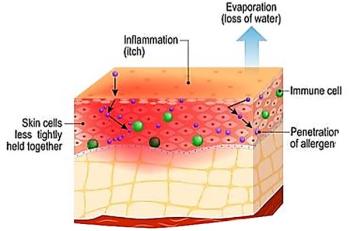
The Journal of Respiratory Diseases
- The Journal of Respiratory Diseases Vol 27 No 3
- Volume 27
- Issue 3
Anxiety and depression in asthma and COPD: Results of recent studies
A number of studies have found an increased prevalence of anxiety and depression in patients with asthma and chronic obstructive pulmonary disease (COPD). Although the relationship is not completely understood, it is clear that psychological disorders can adversely affect the course of both diseases.
A number of studies have found an increased prevalence of anxiety and depression in patients with asthma and chronic obstructive pulmonary disease (COPD). Although the relationship is not completely understood, it is clear that psychological disorders can adversely affect the course of both diseases.
This Clinical Update sums up some of the findings recently reported in the literature.
Asthma and panic disorder
There is growing recognition of the relationship between anxiety, stress, and asthma.1 A number of studies have documented an association between asthma and panic disorder.2-5 For example, a longitudinal community-based study, conducted by Goodwin and Eaton,5 found that the presence of asthma increased the risk of panic in adults. The results of a recent prospective study by Hasler and associates6 are consistent with this but also demonstrate the bidirectional relationship between asthma and panic disorder.
Their study included 591 persons who were observed from age 19 to 40 years.6 The study sample was tailored to include persons at risk for psychiatric disorders.
After adjusting for potential confounders, the analysis indicated that active asthma predicted subsequent panic disorder (odds ratio, 4.5) and panic disorder predicted subsequent active asthma (odds ratio, 6.3). The associations were stronger in smokers than in nonsmokers and were stronger in women than in men. Confounders of the relationship between asthma and panic included smoking, anxiety in early childhood, and a family history of allergy.
A number of mechanisms might account for the link between asthma and panic disorder (Table). Having a potentially life-threatening disease such as asthma probably increases anxiety in many patients and may trigger panic attacks in some. In addition, asthma and panic may share certain risk factors. Smoking, for instance, increases the risk of asthma and impairs the response to asthma therapy7,8; it also increases the risk of panic.9 Stress during childhood has also been identified as a risk factor for both asthma and panic.10-12
•Having a potentially life-threatening disease may increase anxiety, possibly triggering panic.
•Some asthma medications may have anxiogenic properties.23
•Anxiety may result in increased use of asthma medications.24
•Asthma and panic may share certain risk factors, such as smoking and childhood stress.9,10,25
•The increased respiration and hyperventilation associated with panic may trigger airway changes (similar to exercise-induced bronchospasm).26
•The presence of a psychological disorder may be associate with nonadherence to asthma therapy, resulting in poor asthma control.
•The overlap between the symptoms of asthma and panic may result in misinterpretation of symptoms.
•Psychological stress can modulate interactions between the CNS and the immune system.1
Impact on asthma control
It is becoming increasingly clear that psychological variables can influence the onset and course of asthma. Chronic stress, for example, can trigger asthma exacerbations in children.10 Anxiety and depression have been associated with a less favorable asthma-related health status in adults.13
Lavoie and coworkers14 found evidence that the presence of a psychiatric disorder is associated with poorer asthma control and asthma-related quality of life. In their study, 406 adults with asthma underwent a structured psychiatric interview, completed the Asthma Control Questionnaire and Asthma Quality of Life Questionnaire, and underwent pulmonary function testing. The results indicated that 34% had a psychiatric diagnosis, such as major depression (15%), panic disorder (12%), or generalized anxiety disorder (5%).
The presence of a psychiatric diagnosis was not associated with a difference in pulmonary function. However, asthma control and quality of life were worse in patients who had a psychiatric diagnosis.14
COPD, depression, and anxiety
Several studies have found that the prevalence of depression is increased in patients with COPD. Van Ede and associates15 reported that depression was present in 7% to 42% of patients.Another study found that 34% of patients with COPD had an anxiety disorder and 16% had depression.16
Kunik and colleagues17 conducted a study that included 1334 persons who had chronic breathing disorders and were receiving care at a VA medical center. Primary Care Evaluation of Mental Disorders (PRIME-MD) screening questions were used to assess the prevalence of anxiety and depression. The Structured Clinical Interview for the Diagnostic and Statistical Manual of Mental Disorders, 4th edition18 was used to determine the prevalence of anxiety and depression diagnoses in patients with COPD.
The PRIME-MD indicated that 80% of the patients had anxiety or depression. Anxiety or depression was severe in 52% of the patients who had either diagnosis. In the subset of patients with COPD, 65% received a diagnosis of an anxiety and/or depressive disorder. Only 31% of those with such diagnoses were being treated for depression or anxiety; 20% were receiving an antidepressant or anxiolytic agent.
The authors noted that the PRIME-MD had a positive predictive value of 80%.17 They suggested that the use of such screening instruments could improve the underrecognition and undertreatment of depression and anxiety in this patient population.
The need for better recognition of depression and anxiety in patients with COPD is underscored by evidence of the adverse effects on outcomes.19 Gudmundsson and associates20 reported a high incidence of anxiety and depression in 416 patients hospitalized for COPD, and they found that anxiety or depression was associated with poorer health status. These authors also found evidence that anxiety is a risk factor for rehospitalization in patients with COPD.21
A number of factors may contribute to anxiety and depression in patients with COPD. The functional limitations associated with COPD cause or exacerbate depression in some patients. Pulmonary rehabilitation can address some of these concerns. One study found that participation in an outpatient pulmonary rehabilitation program resulted in decreased anxiety and symptoms of depression in patients with COPD.22
References:
REFERENCES
1. Busse WW, Kiecolt-Glaser JK, Coe C, et al. Stress and asthma: NHLBI workshop summary.
Am J Respir Crit Care Med.
1995; 151: 249-252.
2. Goodwin RD, Pine DS. Respiratory disease and panic attacks among adults in the United States.
Chest.
2002;122:645-650.
3. Zandbergen J, Bright M, Pols H, et al. Higher lifetime prevalence of respiratory diseases in panic disorder?
Am J Psychiatry.
1991; 148: 1583-1585.
4. Goodwin RD, Pine DS, Hoven CW. Asthma and panic attacks among youth in the community.
J Asthma.
2003;40:139-145.
5. Goodwin RD, Eaton WW. Asthma and the risk of panic attacks among adults in the community.
Psychol Med.
2003;33:879-885.
6. Hasler G, Gergen PJ, Kleinbaum DG, et al. Asthma and panic in young adults. A 20-year prospective community study.
Am J Respir Crit Care Med.
2005;171:1224-1230.
7. James AL, Palmer LJ, Kicic E, et al. Decline in lung function in the Busselton Health Study: the effects of asthma and cigarette smoking.
Am J Respir Crit Care Med.
2005;171:109-114.
8. Chaudhuri R, Livingston E, McMahon AD, et al. Cigarette smoking impairs the therapeutic response to oral corticosteroids in chronic asthma.
Am J Respir Crit Care Med.
2003;168:1308-1311.
9. Isensee B, Wittchen HU, Stein MB, et al. Smoking increases the risk of panic: findings from a prospective community study.
Arch Gen Psychiatry.
2003;60:692-700.
10. Sandberg S, Paton J, Ahola S, et al. The role of acute and chronic stress in asthma attacks in children.
Lancet.
2000;356:982-987.
11. Vollrath M, Koch R, Angst J. The Zurich Study, IX: panic disorder and sporadic panic: symptoms, diagnosis, prevalence, and overlap with depression.
Eur Arch Psychiatry Neurol Sci.
1990;239:221-230.
12. Klinnert MD, Nelson HS, Price MR, et al. Onset and persistence of childhood asthma: predictors from infancy.
Pediatrics.
2001; 108: E69.
13. Rimington LD, Davies DH, Lowe D, Pearson MG. Relationship between anxiety, depression, and morbidity in adult asthma patients.
Thorax.
2001;56:266-271.
14. Lavoie KL, Cartier A, Labrecque M, et al. Are psychiatric disorders associated with worse asthma control and quality of life in asthma patients?
Respir Med.
2005; 99: 1249-1257.
15. van Ede L, Yzermans CJ, Brouwer HJ. Prevalence of depression in patients with chronic obstructive pulmonary disease: a systematic review.
Thorax.
1999;54:688-692.
16. Yellowlees PM, Alpers JH, Bowden JJ, et al. Psychiatric morbidity in patients with chronic airflow obstruction.
Med J Aust.
1987; 146 : 305-307.
17. Kunik ME, Roundy K, Veazey C, et al. Surprisingly high prevalence of anxiety and depression in chronic breathing disorders.
Chest.
2005; 127:1205-1211.
18. American Psychiatric Association.
Diagnostic and Statistical Manual of Mental Disorders.
4th ed. Washington, DC: American Psychiatric Association; 1994.
19. Peruzza S, Sergi G, Vianello A, et al. Chronic obstructive pulmonary disease in elderly subjects: impact on functional status and quality of life.
Respir Med.
2003;97:612-617.
20. Gudmundsson G, Gislason T, Janson C, et al. Depression, anxiety and health status after hospitalisation for COPD: a multicentre study in the Nordic countries.
Respir Med.
2005 [Epub May 11].
21. Gudmundsson G, Gislason T, Janson C, et al. Risk factors for rehospitalisation in COPD: role of health status, anxiety and depression.
Eur Respir J.
2005;26:414-419.
22. Kayahan B, Karapolat H, Atyntoprak E, et al. Psychological outcomes of an outpatient pulmonary rehabilitation program in patients with chronic obstructive pulmonary disease.
Respir Med.
2005 [Epub October 24].
23. ten Brinke A, Ouwerkerk ME, Bel EH. Similar psychological characteristics in mild and severe asthma.
J Psychosom Rep.
2001; 50:7-10.
24. Dahlem NW, Kinsman RA, Horton DJ. Panic-fear in asthma: requests for as-needed medications in relation to pulmonary function measurements.
J Allergy Clin Immunol.
1977; 60: 295-300.
25. Slattery MJ, Klein DF, Mannuzza S, et al. Relationship between separation anxiety disorder, parental panic disorder, and atopic disorders in children: a controlled high-risk study.
J Am Acad Child Adolesc Psychiatry.
2002; 41: 947-954.
26. Gorman JM, Kent J, Martinez J, et al. Physiological changes during carbon dioxide inhalation in patients with panic disorder, major depression, and premenstrual dysphoric disorder: evidence for a central fear mechanism.
Arch Gen Psychiatry.
2001;58:125-131.
Newsletter
Enhance your clinical practice with the Patient Care newsletter, offering the latest evidence-based guidelines, diagnostic insights, and treatment strategies for primary care physicians.



















































































































































































































































































